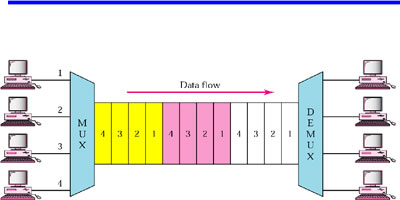Difference between ATM and TDM
Key Difference: ATM and TDM are two types of data transfer technologies. TDM stands for Time-division multiplexing, which is a method of combining multiple data streams into one and sending it together over one signal. ATM stands for Asynchronous Transfer Mode. It is a type of TDM, in which the timeslots are not fixed.
 ATM and TDM are two types of data transfer technologies. TDM stands for Time-division multiplexing, which is a method of combining multiple data streams into one signal via the use of a multiplexer. The multiplexer accepts the input from each individual end user and combines it together. The advantage of it is that it allows the combination of media, such as data, text, graphics, voice and video, to be transferred together.
ATM and TDM are two types of data transfer technologies. TDM stands for Time-division multiplexing, which is a method of combining multiple data streams into one signal via the use of a multiplexer. The multiplexer accepts the input from each individual end user and combines it together. The advantage of it is that it allows the combination of media, such as data, text, graphics, voice and video, to be transferred together.
This signal is then separated into many segments, each having a very short duration. These separate segments can then be transmitted almost simultaneously using the same link. The received segments can then be put together via the help of a demultiplexer. The demultiplexer the separates the data and routes it to the proper end users.

The technology of TDM was developed in the 1800s for use in telegraphy systems. In the digital age, it was utilized in the second half of the 20th century. It is primarily used for digital signals. TDM might also me used for analog multiplexing. In analog multiplexing, two or or more signals or bit streams are transferred appearing simultaneously as sub-channels in one communication channel. However, they are physically taking turns on the channel.
ATM, on the other hand, stands for Asynchronous Transfer Mode. It is a type of TDM, in which the timeslots are not fixed. They are assigned dynamically as needed; hence the name asynchronous, not synced. The advantage of ATM is that it uses a constant data stream to allow the transference of data.
Comparison between ATM and TDM:
Details for the table taken from Cisco Factsheet.
|
|
ATM |
TDM |
|
Stands for |
Asynchronous Transfer Mode |
Time-division multiplexing |
|
Description |
A dedicated-connection switching technology that organizes digital data into 53-byte cell units and transmits them over a physical medium using digital signal technology. |
A method of putting multiple data streams in a single signal by separating the signal into many segments, each having a very short duration. |
|
Cost of ownership |
ATM lowers recurring bandwidth and operation costs |
TDM increases recurring bandwidth and operation costs |
|
Bandwidth efficiency |
ATM enables different applications to share bandwidth while preserving QoS |
TDM does not allow different applications to share bandwidth while preserving QoS |
|
Multi-service capability |
ATM delivers multi-service capability without affecting bandwidth efficiency; |
TDM provides multi-service capability at the expense of bandwidth efficiency |
|
Quality of service (QoS) |
ATM enables QoS without affecting bandwidth efficiency |
TDM enables QoS at the expense of bandwidth efficiency
|
|
Features |
|
|
Image Courtesy: up.edu.ps, feezy1al.blogspot.com









Add new comment